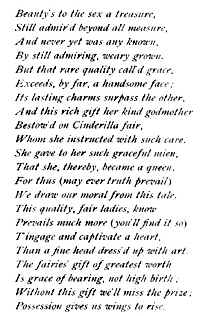| Home | |
| Lesson Plans | |
| Research | |
| Variations | |
| links | |
| Bibliography |
 |
|
|
|
|
Cinderella meets her fairy godmother from Perrault's version by Clark |
The moral to Cinderella (Perrault version) |
|
What About The Fairytale Beginings? |
| Neither the Grimms nor Perrault were the original authors of the tales they published, having collected their own national folk tales from a variety of sources and revised them in keeping with their own sensibilities, their own culture's manners and mores, and the reading audience they hoped to attract. And over the years, with each new publication of what is apparently the same tale simply put into newer print, the stories rarely match word for word. In variations of Grimms' Cinderella the same passages read much differently, proof that the variants of today need only have the main ideas to be considered Cinderella. |
| It's hard to account for the radical difference between "prithee look back" and "rook di goo," both apparently faithful translations of the Grimms' original. Many of the newer versions are complete departures from the Grimms' version and Perrault's, sharing only the characters and the basic plot line, while the story itself is much elaborated, reconstructed or modernized. At the same time, most of us grew up with little understanding of the nature of the original authorship, the dissemination, or the publication of the fairy tales peculiar to our own culture. The Grimms' tales, for example, were gotten by inviting storytellers to come to the Grimms' home, and the storytellers, according to Jack Zipes, tended to be "educated young women from the middle class or aristocracy." |
| But of course these young women could scarcely be said to be the authors of the tales they relayed, having received the stories themselves by word of mouth, the stories handed down from one generation to the next through an oral rather than a written tradition. Many of the tales were repeated by several of the storytellers, all one variant or another, according to the version they'd been used to hearing within their own family circles. Over the course of 45 years, the Grimms published seven editions of their tales, each time adding new stories and revising existing ones either for stylistic reasons, or with an awareness that adult audiences even then were concerned about some of the more explicit content of the stories |
| There appear to be as many Cinderellas as there are languages and discrete geographical and cultural locales, each tale adapted to the customs, the clothing, and the foodstuffs of each place. And although there are several male Cinderella tales, the tale has resonated primarily with a female audience, as have all the popular fairy tales. Despite the mystery of its origin and authorship, the fairy tale is a children's and a woman's genre. |
| This is not to say that all women agree on the appropriateness of fairy tales or their influence and cultural significance. Many women find the traditional fairy tale sexist, suggesting that the tales traffic in cultural stereotypes that prize only beauty and passivity in girls and women. Others feel that many of the tales emphasize feminine resourcefulness and ingenuity. Still others, examining the traditional Western versions with other-cultural versions, suggest that their own versions write a strong and independent child who wins her future by her own hard work rather than relying on the phantoms or materialist trappings of the tales of Western cultures. |
Some articles that I found useful when I began the process of compiling information and determining if Cinderella was the fairy tale that would best lend itself to cross age and cross cultural teaching.
The Cinderella fairy tales can be
used effectively in high school and middle school curriculum because the
familiarity of these tales make them appealing to adolescent readers (de
Vos). Interest in these fairy tales remains an influence on students of all ages. Young scholars can become more interested in writing because the formula of the fairy tale allows them to feel comfortable in completing a cohesive story (Hall). Reading versions told from other viewpoints can help children understand critical reasoning, fairness in dealing with others, and forming judgements based on positive values (Granowsky). While literacy is an important part of anyone's education, it should be noted that visual literacy, being able to view, interpret and react to visuals, is just as important for today's population. Once college students begin to really examine art work, they do come away more satisfied with their abilities to judge the quality of the art work presented. In responding to illustrations, there are a number of areas of concentration: (1) color; (2) borders; (3) style; and (4) viewing distance. The style with which "Cinderella" is illustrated has a dramatic effect on the reader's understanding of the text ( Storey). |

